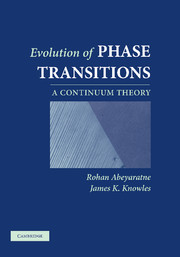Book contents
- Frontmatter
- Contents
- Preface
- Part I Introduction
- Part II Purely Mechanical Theory
- Part III Thermomechanical Theory
- Part IV One-Dimensional Thermoelastic Theory and Problems
- 9 Models for Two-Phase Thermoelastic Materials in One Dimension
- 10 Quasistatic Hysteresis in Two-Phase Thermoelastic Tensile Bars
- 11 Dynamics of Phase Transitions in Uniaxially Strained Thermoelastic Solids
- Part V Higher Dimensional Problems
- Author Index
- Subject Index
10 - Quasistatic Hysteresis in Two-Phase Thermoelastic Tensile Bars
Published online by Cambridge University Press: 12 August 2009
- Frontmatter
- Contents
- Preface
- Part I Introduction
- Part II Purely Mechanical Theory
- Part III Thermomechanical Theory
- Part IV One-Dimensional Thermoelastic Theory and Problems
- 9 Models for Two-Phase Thermoelastic Materials in One Dimension
- 10 Quasistatic Hysteresis in Two-Phase Thermoelastic Tensile Bars
- 11 Dynamics of Phase Transitions in Uniaxially Strained Thermoelastic Solids
- Part V Higher Dimensional Problems
- Author Index
- Subject Index
Summary
The purely mechanical quasistatic response of one-dimensional, two-phase elastic bars was discussed in Chapter 3. In the present chapter, we shall generalize that discussion to incorporate thermal effects. After setting out some preliminaries in Section 10.1, in Section 10.2 we describe the thermomechanical equilibrium states of a two-phase material. Quasistatic processes, taken to be one-parameter families of equilibrium states, are studied in Section 10.3. We specialize the discussion to a trilinear thermoelastic material in Section 10.4 and then evaluate the response of the bar to some specific loading programs: in Sections 10.5, 10.6, and 10.7 we consider stress cycles at constant temperature, temperature cycles at constant stress, and the shape-memory cycle respectively; qualitative comparisons with some experiments are also made in these sections. In Section 10.8 we describe an experimental result of Shaw and Kyriakides [15, 16] and compare the theoretical predictions of our model with it. Finally in Section 10.9 we comment on processes that are slow in the sense that inertial effects can be neglected but are not quasistatic in the preceding sense of being one-parameter families of equilibrium states.
Preliminaries
We begin by setting out the one-dimensional version of the theory of thermoelasticity given in Chapter 7. Consider a tensile bar that occupies the interval [0, L] of the x-axis in a reference configuration.
- Type
- Chapter
- Information
- Evolution of Phase TransitionsA Continuum Theory, pp. 163 - 180Publisher: Cambridge University PressPrint publication year: 2006



